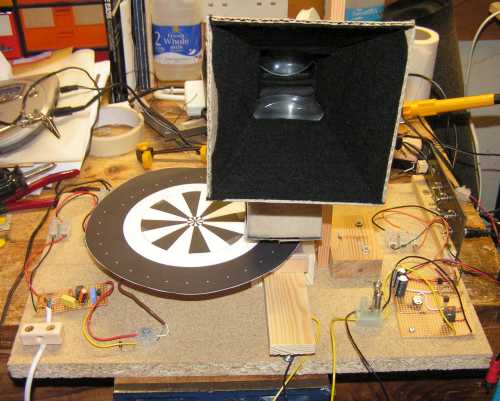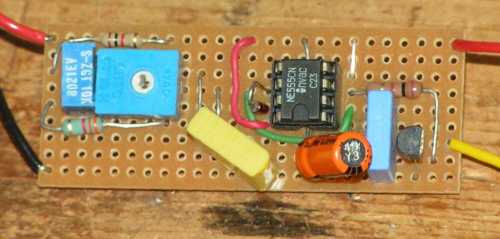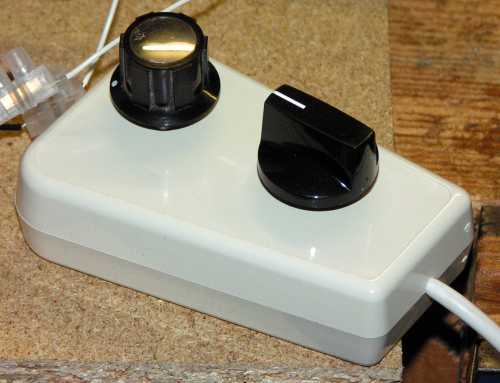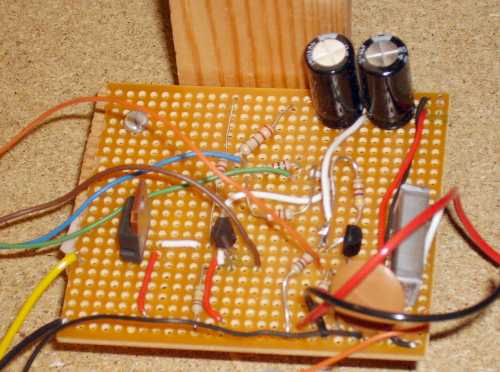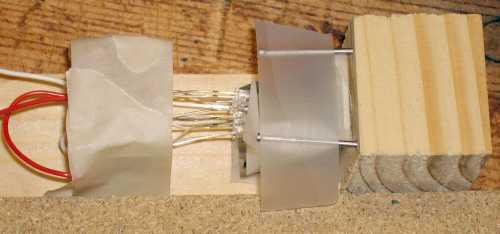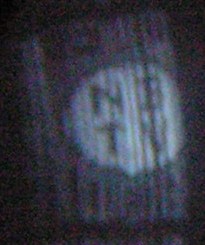 |
|||||||||||||||
|
|
|||||||||||||||
|
I like building things - and for a long time I’ve wanted to build a mechanical television system. If you’re wondering what one is and why I’d want to build one anyway then click HERE Anyway - as a recent joiner of the NBTVA I decided to build a Nipkow disk monitor based around the NBTVA 32 line standard. Its pretty crude - but largely finished. The following picture shows what it looks like as of March 2007.
There are 4 main components: 1) The Nipkow disk. This is a thin cardboard disk into which a spiral of 32 pinholes has been punched. When the disk is rotated at 750 RPM the holes completely scan a small picture area 12.5 times a second. Each hole provides one of the 32 vertical scan lines (as opposed to the 625 horizontal ones of modern PAL TV as used in the UK). By varying a bright light behind the disk the scan line is broken down into pixels of different shades and the eye’s persistence of vision causes the whole picture to appear as one. The dartboard pattern in the middle has a use too. When viewed under a 50Hz electric light - the pattern appears stop rotating when the disk is running at 750RPM I got my basic Nipkow disk from HERE. One major point to note is that I use a mirror to reflect the image through a lens for viewing. In order to achieve this - I rotate the disk clockwise (normally they go anti clockwise) and I’ve also mirrored the spiral. 2) The motor drive circuit. The disk needs to rotate at 750 RPM to achieve correct synchronisation with the input signal. Initially I used a variable resistor to control the motor speed. The circuit illustrated is my 2nd version which utilises a 555 timer chip to produce a Pulse Width Modulated (PWM) signal This is a variation of the circuit described HERE. The picture below still shows the 2 presets I originally used - one coarse and one fine for more accurate speed control. These have now been replaced with a wired remote control (see below). The motor itself is a 6v model from a 1970s radio/cassette deck.
3) The amplifier and LED driver circuit. The light has to be bright but also able to respond quickly to input signal changes. The circuitry is based partially on the one found HERE with a lot of help from the guys on the NBTV forum
The mirror is only necessary as there is not enough room behind the Nipkow disk to place the LEDs far enough away to properly diffuse. Usually the Nipkow disk would be mounted at right angles to the baseboard (much like my next monitor) and so the mirror is not needed.
4) The signal source. I used a pre-recorded signal from a CD bought from the NBTVA. I also made my own CDs using the video converter software found HERE. To play the CD I use a small portable CD player - though initially all I had to hand was a spare Sony Playstation 1! The choice of player does not matter too much as the CD contains an audio type signal and is not a CD-ROM. The main requirement is that the CD player has a line out connector. So where you may ask are the results? Well the pictures from this very simple mechanical TV monitor are small and flickery and not easy to photo. Also as they are low resolution they show movement much better than detail. However I did manage to take this photo which shows one of the standard NBTV logos:
If you’d like to have a go at this - but don’t want to build any hardware - a complete and free software only solution for Windows can be found HERE..
|
|
All text and images Copyright © 2000-2011 Roland Givan, unless otherwise stated. All Rights Reserved. Game artwork copyright their respective publishers. |
|
[Home Page] [Fire Engine (1)] [Toy Train] [Lathe page] [Joystick Interfacing] [Mechanical TV] |
